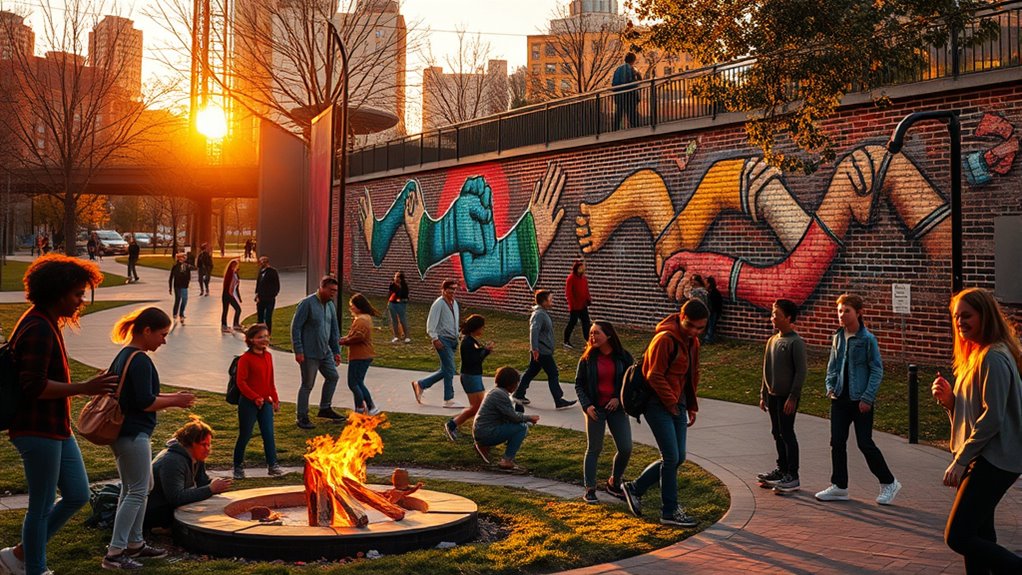To combat loneliness among youth, focus on building genuine connections both online and offline. Use social media thoughtfully to create peer support networks where you can share experiences and find understanding. At the same time, participate in face-to-face activities like clubs, sports, or volunteering to deepen relationships and strengthen community bonds. Balancing these approaches helps foster a sense of belonging. Keep exploring ways to connect more meaningfully—you’ll find more tips that can make a real difference.
Key Takeaways
- Encourage participation in offline activities like sports, clubs, or volunteering to build deeper real-world connections.
- Promote mindful social media use to develop authentic peer support networks that foster understanding and mutual support.
- Teach communication skills and emotional expression to help youth forge meaningful relationships.
- Support the development of online communities centered on shared interests and mental health to reduce feelings of isolation.
- Emphasize that seeking help and reaching out is a sign of strength, helping youth feel more confident in forming connections.

Have you ever felt isolated even when surrounded by people? It’s a common experience among youth today, often amplified by the pervasive influence of social media’s impact. While social media connects us instantly, it can also create a false sense of companionship, leaving you feeling lonelier than before. Endless scrolling can make you compare yourself to others, fostering feelings of inadequacy and alienation. Yet, social media isn’t inherently bad; it’s how you use it that counts. When used mindfully, it can serve as a tool to build peer support networks that actively combat loneliness. These networks allow you to find others who share your interests, struggles, and experiences, giving you a sense of belonging. Connecting with like-minded peers through online communities can provide comfort and understanding, especially when face-to-face interactions are limited or intimidating.
Social media can build supportive communities that foster belonging and understanding.
Building and nurturing peer support networks requires intentional effort. Instead of passively consuming content, you can seek out groups that focus on your hobbies, mental health, or personal growth. These communities facilitate genuine connections, fostering empathy and mutual support. Sharing your feelings and listening to others’ stories can break down the walls of loneliness, reminding you that you’re not alone in your experiences. It’s important to remember that these digital bonds can translate into real-world friendships, offering a foundation for in-person interactions. Engaging regularly with these networks helps create a sense of routine and stability, which is essential for mental well-being. Additionally, understanding asset division laws can empower you to navigate complex situations confidently should your circumstances change, contributing to your overall sense of security.
However, it’s imperative to balance online interactions with offline activities. While peer support networks are valuable, they shouldn’t replace in-person connections. Participating in community events, sports, clubs, or volunteering provides opportunities for face-to-face engagement. These activities help develop deeper bonds and reinforce your sense of community. Combining online support with real-world involvement creates a holistic approach to fighting loneliness. Remember, reaching out isn’t a sign of weakness; it’s a step toward building meaningful relationships. Whether through social media or in person, opening up and expressing your feelings can alleviate the weight of loneliness.
In the end, combating loneliness among youth involves leveraging both technology and traditional social avenues. Social media’s impact can be harnessed positively when used to foster authentic connections, especially through peer support networks. By actively seeking out and maintaining these relationships, you can transform feelings of isolation into a sense of belonging and purpose. You’re not alone in this journey—there are countless others looking for connection, just like you.
Frequently Asked Questions
How Can Schools Better Support Lonely Students?
You can support lonely students by implementing peer mentoring programs that foster connections and understanding. Schools should also develop inclusive curricula that celebrate diversity and promote empathy, making students feel valued and understood. Encourage teachers to recognize signs of loneliness and create safe spaces where students can share their feelings. These efforts help build a supportive community, ensuring no student feels isolated and everyone has opportunities to form meaningful relationships.
What Role Does Social Media Play in Youth Loneliness?
You might believe social media connects you, but digital dependency can actually deepen youth loneliness. Online validation becomes a fleeting fix, making you crave more likes and comments while feeling more isolated. The truth is, social media often amplifies feelings of inadequacy and disconnection, rather than easing loneliness. Recognizing this helps you prioritize genuine face-to-face interactions, breaking free from the cycle of digital dependency and fostering real, meaningful connections.
Are There Specific Activities That Reduce Loneliness Effectively?
You can reduce loneliness effectively by engaging in group activities and skill workshops. These activities help you connect with others who share your interests, fostering a sense of belonging. Participating regularly in team sports, arts classes, or community projects encourages deeper relationships and boosts your confidence. By actively involving yourself in these social settings, you create meaningful bonds that diminish feelings of loneliness and promote emotional well-being.
How Can Parents Recognize Signs of Loneliness in Teenagers?
Like finding a lighthouse in a foggy night, recognizing signs of loneliness in your teen requires emotional awareness and attention to peer connection. Look for changes in their mood, withdrawal from friends, or declining interest in activities they once loved. If they seem unusually quiet, irritable, or avoid social situations, these could be signals they’re struggling. Engaging them in open conversations shows you care and helps strengthen their emotional resilience.
What Mental Health Resources Are Available for Lonely Youth?
You can access mental health resources like peer counseling programs and online support groups designed specifically for lonely youth. Peer counseling offers a safe space where you can share your feelings and get guidance from trained peers. Online support communities provide a sense of connection and understanding, helping you feel less isolated. Reach out to school counselors or mental health organizations to explore these resources and find the support you need.
Conclusion
As you take steps to connect with others, remember that loneliness isn’t a battle you face alone. Small actions can lead to unexpected friendships, but the real challenge lies ahead. Will you let fear hold you back, or will you seize the chance to build genuine bonds? The path to overcoming loneliness is filled with surprises—are you ready to discover what’s waiting just beyond your comfort zone? Your journey starts now.










